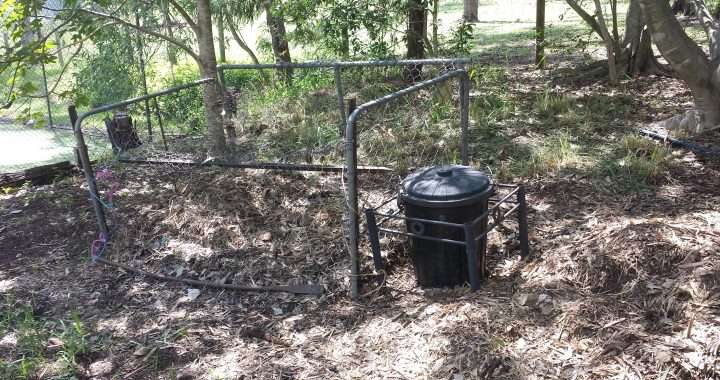
Making compost from a compost bin in 2 months – made simple
Author : My Food Garden
Making compost is an essential part of an organic gardener’s yearly activity.There are many ways to make compost and this blog concentrates on one simple method which I think overcomes a very common challenge. I have also done a short movie to support the content of this blog.
To deal with daily food waste, we have chickens and we have a simple black plastic rubbish tin with a hole in the bottom. The food scraps are leafies, skins and bones. The bin has a cover on the top so its animal proof. I have found over the years that the bin gets anaerobic quite fast, mainly because the ingredients are very moist. I have experimented with adding dry matter when I add wet and it helps a little but the result is still not ideal for making compost.
When the contents are anaerobic, they become sticky, smelly and are teaming with soldier fly larvae. Those little critters do a good job but it does take a long time to finish off. Often its very hard for compost to complete when new substance is continually added to half finished off old substance.
What I have done in the past, before discovering the new method I will describe below for making compost, is to add the partially completed full bin of “goey stuff” to my larger biodynamic compost process where I make 1-2 cubic metres of compost. That process takes about 4 months with no turning and produces great compost. The image about is a compost making activity at our last biodynamic gardening workshop.
As you can see on the movie, we have a wire enclosure next to our black compost bin. It stops the common animals we have from getting in, such as: rabbits, bush turkeys, possums, crows, bandicoots and bush rats.
Our compost bin takes about one month to fill with our kitchen scraps. Once full, I then tip the whole contents of the bin into half of the wire enclosure, cover it with about 5cm of soil and a heavy mulch layer. Because the mixture now has lots of air around it, soil and more life from under the earth, it breaks down very quickly into compost. This environment not only enables the soldier fly larvae to do their work more effectively, but also creates a good environment for worms and other small creatures to get involved.
I have found that the anaerobic mixture worked this way turns into usable compost within about 1 month. No turning involved. At the end of the month I dig it up and start mixing it into soil. I normally add a bit of finely crushed rock dust to the mixture before putting into the soil as this adds further easily accessible food for the micro-organisms.
I also enhance the mixture with a biodynamic soil conditioner which has the biodynamic compost preparations in it and this also helps to concentrate and balance the key minerals: silica, calcium, phosphorous, potassium, nitrogen and sulphur.
When its warm and wet the mixture finishes off faster. When its warm and dry the process may need some moisture, but in my experience, because the starting mixture is in a wet anaerobic state, I have not needed to watered it. If the temperature is cold, the process will be slower so I suggest insulating it with a thicker layer of mulch.
The volume of compost from a standard size rubbish bin is a quarter of a normal barrow. We have other composting processes to deal with our plants scraps, animal manures, grasses etc. These produce a lot more compost and are normally done so the completed compost is available for our peak planting times.
Come along to one of our Workshops or talk to us about our Coaching service.
Happy composting – Peter Kearney

